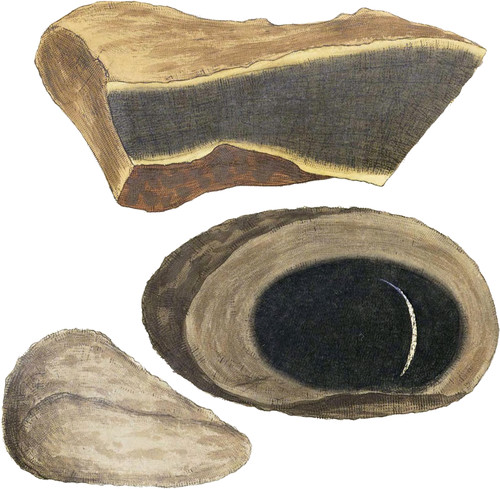 Enlarge
Enlarge
British Mineralogy
Rotten Stone
In Derbyshire, about two miles west of Bakewell, is found some variety of this remarkable, substance in land belonging to the Duke of Rutland. It is said to be found also in Shropshire and Somersetshire, and I have a seemingly chance specimen from Sussex, by favour of Mr. Borrer. Near Bakewell it is found in broken nodules or fragments in the upper soil to about eighteen inches deep or more. It should appear that some parts of the rocks in the neighbourhood are in a state suited to a certain decomposition, by exposure on the common surface, mouldering in a peculiar maimer into a more or less coherent, fine, dusty, soft, but somewhat granular appearance. The rock varies from a light brown to a deeper and grey or blackish hue. In decomposition it becomes lighter, and passes from dark to light yellowish brown, in which state it is commonly called Rotten Stone. It is sold to be used in manufactories for polishing metals, &c.; but is more particularly necessary to the lapidaries*, who polish the harder stones with it, by the help of water, and the substance of their machine being of a harder or softer metal according to the nature of the stone, as Lead, Copper, &c. Nature in this, as is always invariably the case, has furnished us with a substance so nicely suited to this particular purpose, that it is an error in any author to place it indiscriminately with Tripoli; at least with that from Tripoli, which is sold in the shops for polishing (chiefly metals); and being now rare, they recommend Rotten Stone and Crocus Martis†, &c,, for those purposes; although neither the Tripoli nor the Crocus Martis would at all suit the true lapidary.
The upper specimen is part of an irregular flattish fragment of a lightish colour, begining to decompose. The middle figure is part of a nodule decomposing on the outside: the curved line in the middle is part of a petrified shell, which is composed of Carbonate of Lime. The darker part is hard, looking like black Limestone (and much resembles the black Calp of the Irish, having also a similar fœtid odour, quite offensive when scraped); but that is of a texture more durable, else it would not be used for tombstones and paving.
The lower specimen is probably altogether Rotten Stone, or wholly decomposed rock, although it cannot be positively known by outward aspect, as even the best lapidaries have experienced.
Mr. Richard Phillips has analysed the Rotten Stone, and kindly favoured us with the result, as under;
| Alumine | 86 |
| Silica | 4 |
| Carbonaceous matter | 10 |
| 100 |
Tripoli is said to contain
| Silica | 90 |
| Alumine | 7 |
| Oxide of Iron | 3 |
| 100 |
although the Alumine and Iron are in general in greater proportion.
- * Lapidaries sometimes cut and polish the more curious glass, imitative of precious stones (commonly called paste); but this is considered as rather degrading to the profession, and it might seem degrading to the glass polishers to teach them to polish glass. Rotten Stone is certainly so hard in its nature, as rather to grind the glass, as they would call it. Putty is used for polishing glass. It is an Oxide of Tin.
- † A rust of Iron, now often called Tripoli; rendering the truer Tripoli more obscure.

